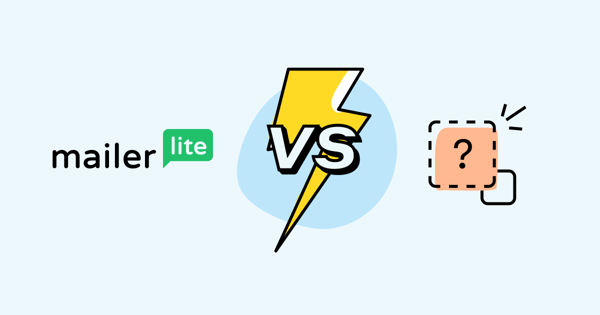MailerLite is best known as a low-cost email marketing platform.
(Probably because it’s called “MailerLite”).
That reputation is actually a little misleading. MailerLite offers a wealth of additional functionality beyond email, giving users the power to build websites and landing pages, create high-converting signup forms, and integrate with their favorite ecommerce tools.
But lots of other platforms do the same stuff. So which is right for your business? To help you make an informed choice, we’ve compared the top 10 MailerLite alternatives by:
- Price
- Product features
- Customer support
- Pros and cons
- Target audience
Let’s dive in…
What is the Best MailerLite Alternative?
| MailerLite Alternatives | Best For | Top Features | Pricing/Month |
| Drip | DTC ecommerce | Segment your whole audience based on real-time store, visitor, and marketing data. | From $39 per month for up to 2,500 contacts and unlimited email sends. |
| Klaviyo | Ecommerce agencies and developers | Personalization and segmentation tools allow you to create customer segments based on real-time data. | Free for up to 250 contacts and 500 monthly email sends; paid plans priced from $45 per month for up to 1,000 contacts and 10,000 monthly email sends. |
| Mailchimp | Small businesses | Advanced analytics and reporting help marketers make data-driven decisions. | Free for up to 500 contacts and 1,000 monthly email sends; paid plans start at $9.99 per month for 500 contacts and 5,000 monthly email sends. |
| Omnisend | Ecommerce marketers | Web push notifications allow brands to instantly retarget customers. | Free to reach up to 250 contacts per month, including 500 monthly email sends, up to 60 SMS messages, and up to 500 web push notifications. |
| AWeber | Startups and small businesses | Create email templates in seconds using your website or Facebook page URL. | Free for up to 500 email subscribers and 3,000 monthly email sends; paid plans priced from $16.15 per month for up to 2,500 subscribers. |
| ConvertKit | Content creators | Integrated newsletter referral program helps creators grow their reach by leveraging their existing audience. | Free for up to 1,000 subscribers and unlimited email sends; paid plans start at $9 per month for up to 300 subscribers and unlimited sends. |
| Brevo (FKA Sendinblue) | Low-budget email marketing | Send transactional emails with guaranteed 97 percent deliverability. | Free for unlimited contacts and up to 300 emails per day. Paid plans start at $25 per month for unlimited contacts and 20,000 emails per month. |
| Constant Contact | Nonprofits and charities | Manage campaigns on the go from a dedicated mobile app. | From $9.99 per month for up to 500 contacts and 12,000 monthly email sends. |
| GetResponse | Small businesses that need advanced marketing tools | Built-in GPT-3.5 powered email generator. | Free for up to 500 contacts and 2,500 monthly email sends. Paid plans start at $15.58 per month for 1,000 contacts and unlimited email sends. |
| HubSpot | B2B inbound marketing | Connect marketing, sales, content management, and customer service in a single platform. | Free marketing plan includes unlimited contacts and 2,000 monthly email sends. Paid marketing plans start at $18 per month for 1,000 contacts and 5,000 monthly sends. |
The 10 Best MailerLite Alternatives
1. Drip
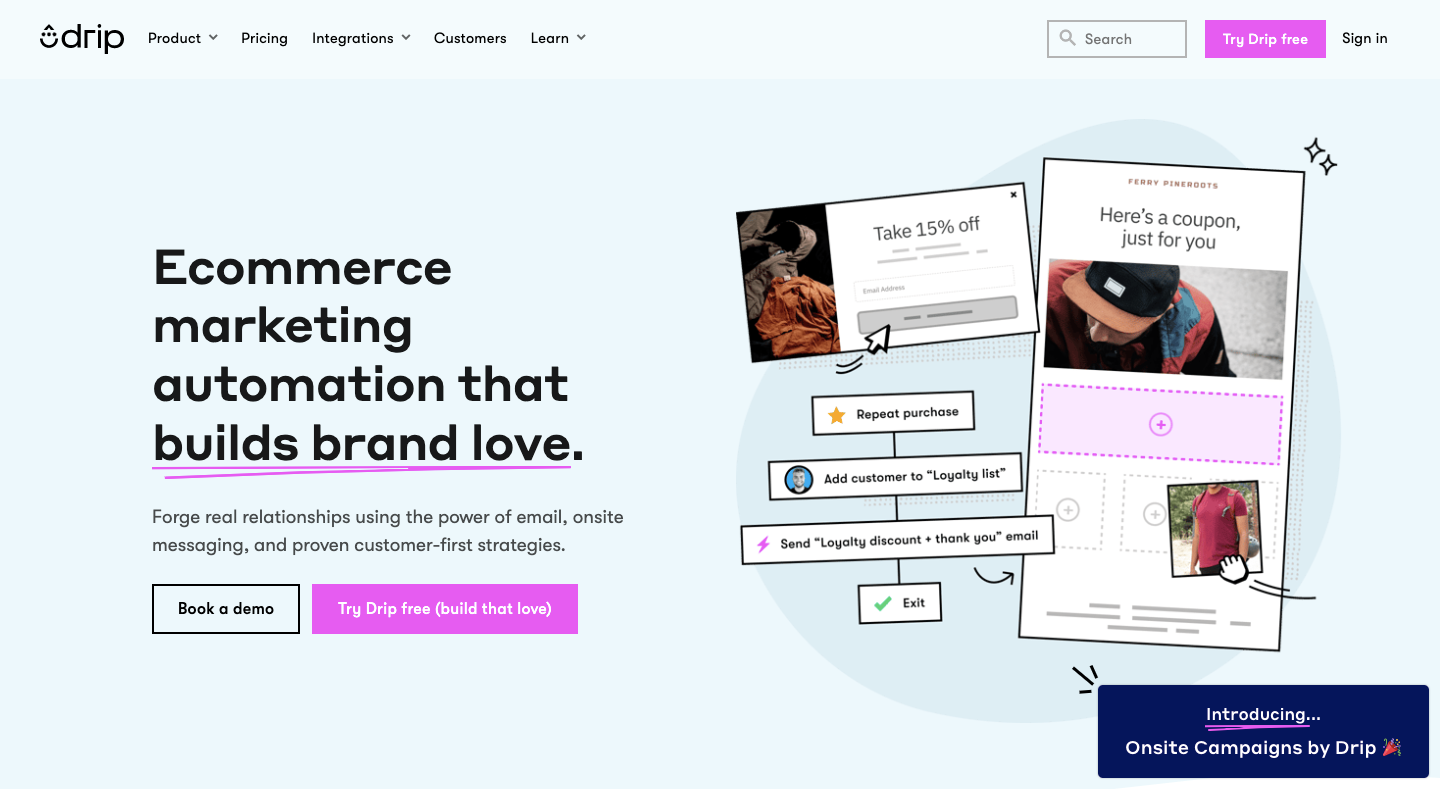 Hey, look, it’s us! We’re Drip, a marketing automation platform built specifically for ecommerce brands—particularly DTCs. Our tools make it quick and easy for brands like yours to deliver laser-targeted email marketing and onsite campaigns personalized to the behaviors and preferences of your customers. And you can do it all yourself, without any advanced technical skills.
Hey, look, it’s us! We’re Drip, a marketing automation platform built specifically for ecommerce brands—particularly DTCs. Our tools make it quick and easy for brands like yours to deliver laser-targeted email marketing and onsite campaigns personalized to the behaviors and preferences of your customers. And you can do it all yourself, without any advanced technical skills.
What Makes Drip the Best MailerLite Alternative?
- Built for ecommerce. Most email platforms (MailerLite included) are all-rounders offering generalist tools catering for a wealth of industries. Not us. We built Drip from the ground up with ecommerce businesses in mind—so everything we do is geared toward driving ecommerce leads, sales, and revenue.
- Developed for ecommerce. Our product development is 100 percent ecommerce-focused, so every time we add a new feature or tool, you can be sure it’s designed to tackle a common ecommerce marketing pain point or deliver on a specific ecommerce goal. MailerLite serves customers in multiple industries, and it has to satisfy them all, resulting in a more generic development pathway.
- Ecommerce-driven UI. MailerLite has a beautiful, clean interface. But it caters to a wide range of audiences, so there are inevitably some features and menus that just weren’t built for businesses like yours. Because ecommerce is Drip’s whole thing, our UI makes it simple to find all the crucial ecommerce automations, data, and tools you need, without any noise or clutter.
- Specialist strategic support. We know what amazing ecommerce marketing looks like, because it’s all we do. Our support team isn’t just here to offer basic technical advice—we’ll pull up a (metaphorical) chair, dig into your strategy and goals, and offer solutions tailored to your ecommerce brand. MailerLite’s customer support is fast and friendly, but it’s more about troubleshooting than strategic guidance.
- Advanced onsite marketing capabilities. Our addition of Sleeknote, a feature-rich onsite form and popup-building platform, gives us a clear edge when it comes to onsite ecommerce marketing. MailerLite’s form builder is perfectly functional but lacks our wealth of customization and personalization options.
- Revenue-focused reporting. We understand that revenue is the be-all and end-all for ecommerce brands, so we make it super easy to understand the ROI of your campaigns. Access revenue metrics for every automation and email, and view Drip-attributed sales to see exactly how much revenue you’re generating through our platform. MailerLite’s reports are more focused on engagement, and it only offers ecommerce tracking for Shopify and WooCommerce stores.
How Does Drip Compare to MailerLite?
| Drip | MailerLite | |
| Best Feature | Segment your whole audience based on real-time store, visitor, and marketing data. | Extremely generous free-for-life plan, including marketing automation and website, landing page, and form-building functionality. |
| Best For | DTC ecommerce | Email marketing beginners |
| Pros | A dedicated ecommerce platform, not a generalist tool. | Has a superb free plan, low prices, and a suite of easy-to-use tools perfect for small businesses, entrepreneurs, and content creators. |
| Cons | If you’re not in ecommerce, Drip isn’t the best fit. | Limited advanced functionality like revenue attribution; lack of ecommerce tracking for platforms other than Shopify and WooCommerce. |
| Pricing/Month | From $39 per month for up to 2,500 contacts and unlimited email sends. | Free for up to 1,000 subscribers, including 12,000 monthly emails. Paid plans start at $9 per month for 1,000 subscribers and unlimited emails. |
| Support | Our support is rated 8.8 on G2 (vs. an average of 8.6 for marketing automation platforms) and includes live audio screen sharing to solve problems in real time. | Free MailerLite accounts include 24/7 email and chat support for the first 30 days. All paying customers get 24/7 email support, while Advanced subscribers also get access to round-the-clock live chat support. |
2. Klaviyo
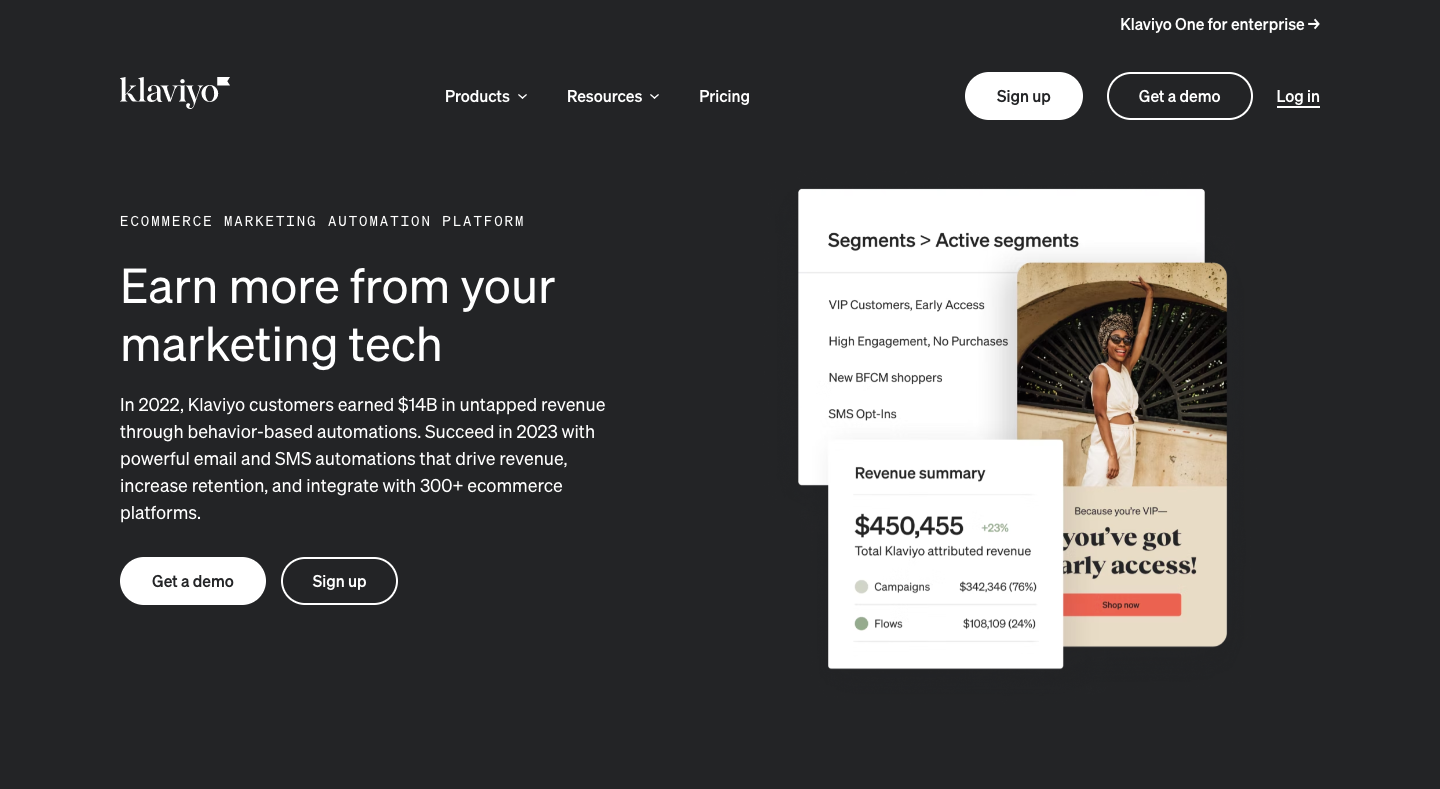 Klaviyo is an ecommerce-specific marketing automation platform for email, SMS, and push notifications. Unlike Drip, it’s not exactly a DIY platform; you’ll need advanced technical skills (and ideally an in-house dev team or full-service Klaviyo agency) to unlock its potential. For that reason, it’s most popular with big retailers and ecommerce brands.
Klaviyo is an ecommerce-specific marketing automation platform for email, SMS, and push notifications. Unlike Drip, it’s not exactly a DIY platform; you’ll need advanced technical skills (and ideally an in-house dev team or full-service Klaviyo agency) to unlock its potential. For that reason, it’s most popular with big retailers and ecommerce brands.
What Makes Klaviyo the Best MailerLite Alternative?
- Built for selling online. If you’re looking for specific ecommerce functionality and you’ve got the necessary tech skills, Klaviyo does a better job than MailerLite, a more generalist platform.
- Built-in CRM. You can technically use MailerLite as a sort-of CRM, but only if you can get by with extremely basic functionality. Klaviyo, on the other hand, has a built-in CRM designed with ecommerce brands in mind, allowing users to better understand their customers.
- Commerce-oriented dashboard. Klaviyo’s dashboard gives you at-a-glance access to store revenue, revenue per campaign, and revenue per automation. Meanwhile, the MailerLite dashboard is all about engagement (think open rates, click-through rates, click-to-open rates). Still useful data, but not the stuff that really makes your business tick.
- More integrations. Klaviyo features 300+ pre-built integrations with all your favorite ecommerce tools, from Gorgias to LoyaltyLion to ShipStation. MailerLite has 140 integrations (including 22 specific ecommerce integrations). That’s still plenty, but if this is a numbers game, Klaviyo wins hands down.
- More templates. Klaviyo has a library of 100+ ecommerce templates covering email, SMS, forms, and automations. MailerLite has lots of templates, too, and they’re beautifully designed—but only a handful are ecommerce-specific.
Is Klaviyo too expensive? Check out our piece on the best Klaviyo alternatives on the market.
How Does Klaviyo Compare to MailerLite?
| Klaviyo | MailerLite | |
| Best Feature | Personalization and segmentation tools allow you to create customer segments based on real-time data. | Extremely generous free-for-life plan, including marketing automation and website, landing page, and form-building functionality. |
| Best For | Ecommerce agencies and developers | Email marketing beginners |
| Pros | Sophisticated ecommerce features and reporting. | Extremely user-friendly and far cheaper than Klaviyo. |
| Cons | Requires advanced technical skills (or, ideally, a full-service Klaviyo agency) to use it effectively. | Lacks Klaviyo’s advanced ecommerce functionality. |
| Pricing/Month | Free for up to 250 contacts and 500 monthly email sends; paid plans priced from $45 per month for up to 1,000 contacts and 10,000 monthly email sends. | Free for up to 1,000 subscribers, including 12,000 monthly emails. Paid plans start at $9 per month for 1,000 subscribers and unlimited emails. |
| Support | After the extensive onboarding program, support is limited to live chat and emails. | Free MailerLite accounts include 24/7 email and chat support for the first 30 days. All paying customers get 24/7 email support, while Advanced subscribers also get access to round-the-clock live chat support. |
3. Mailchimp
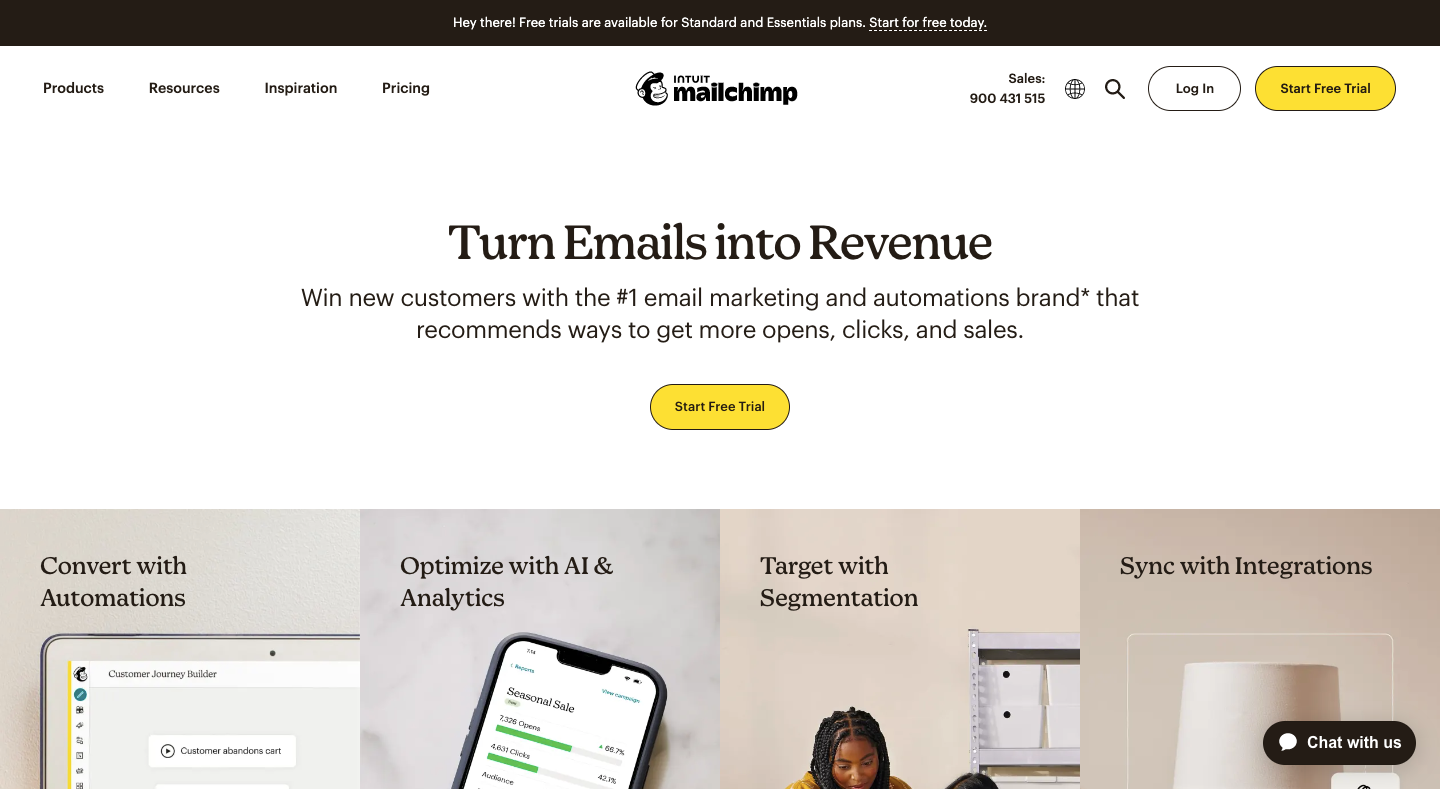 Mailchimp is comfortably the world’s most popular email marketing platform, with a mammoth 66 percent market share at time of writing. But while millions of businesses use Mailchimp, the company drew fire for hiking its prices and gutting its once-beloved free tier, leaving it open to cheaper, more feature-rich competitors—like MailerLite.
Mailchimp is comfortably the world’s most popular email marketing platform, with a mammoth 66 percent market share at time of writing. But while millions of businesses use Mailchimp, the company drew fire for hiking its prices and gutting its once-beloved free tier, leaving it open to cheaper, more feature-rich competitors—like MailerLite.
What Makes Mailchimp the Best MailerLite Alternative?
- Easy to pick up and go. Mailchimp is a cinch to use, even if you’re a total email marketing novice. MailerLite is extremely user-friendly, too, but you need to complete the platform’s approval process before sending emails. And if you’re importing 1,000+ contacts, you’ll need to verify how you acquired them. So it’s a little trickier to hit the ground running with MailerLite.
- Built-in CRM. As we’ve already noted, MailerLite doesn’t have a proper CRM. Mailchimp does have a CRM, and while the functionality is a little limited, it does allow you to see how much revenue you’ve generated from each contact.
- More advanced design testing. With MailerLite, you can preview how emails will look on mobile and desktop before sending. But Mailchimp goes much further, letting you see design previews for different email clients.
- Integrate with more tools. Mailchimp offers 300+ integrations across 20 categories, including design, ecommerce, and point of sale. That’s more than double MailerLite’s number of integrations.
- Free email templates. MailerLite might have the best free product tier in the email marketing game, but it doesn’t include access to any email templates. By contrast, free Mailchimp users can access a limited number of professionally designed templates.
- More sophisticated reporting. Mailchimp’s reports are some of the best on the market, incorporating all the basic stuff like clicks and open rates alongside social media and email client stats. And it has a direct Google Analytics integration. MailerLite is far more limited here.
Need features Mailchimp doesn’t have? Check out our best Mailchimp alternatives for ecommerce.
How Does Mailchimp Compare to MailerLite?
| Mailchimp | MailerLite | |
| Best Feature | Advanced analytics and reporting help marketers make data-driven decisions. | Extremely generous free-for-life plan, including marketing automation and website, landing page, and form-building functionality. |
| Best For | Small businesses | Email marketing beginners |
| Pros | A generalist email automation platform that’s easy to use. | Does most of the stuff Mailchimp does (and a few things it doesn’t) at a much cheaper price point. |
| Cons | Significantly more expensive, despite offering similar functionality. | Far more basic reporting makes it harder to optimize campaigns. |
| Pricing/Month | Free for up to 500 contacts and 1,000 monthly email sends; paid plans start at $9.99 per month for 500 contacts and 5,000 monthly email sends. | Free for up to 1,000 subscribers, including 12,000 monthly emails. Paid plans start at $9 per month for 1,000 subscribers and unlimited emails. |
| Support | Paid plans include 24/7 support via chat and email. Phone and priority support is only available to Premium customers paying $350+ per month. | Free MailerLite accounts include 24/7 email and chat support for the first 30 days. All paying customers get 24/7 email support, while Advanced subscribers also get access to round-the-clock live chat support. |
4. Omnisend
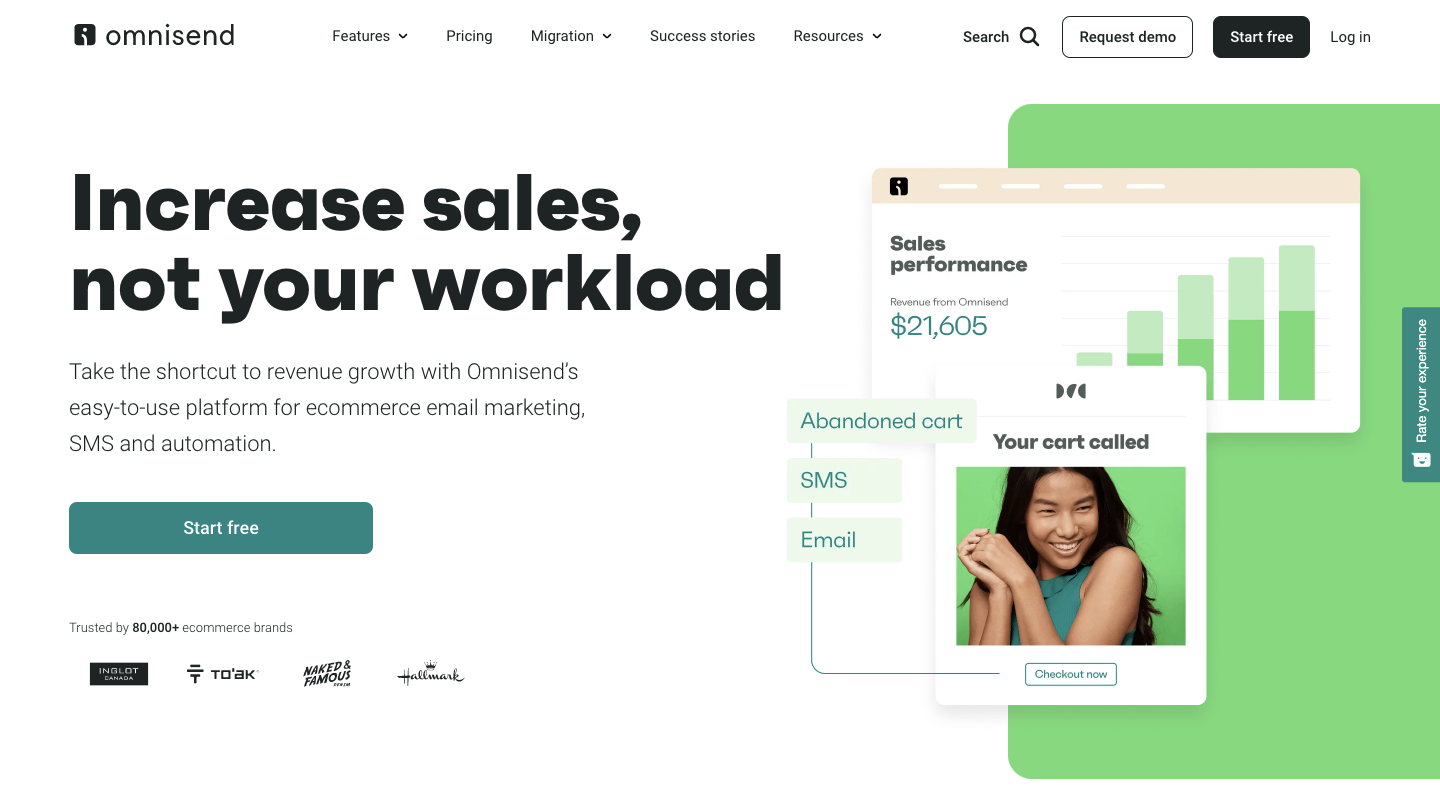 Omnisend is another ecommerce-oriented marketing automation platform that allows brands to build and send email, SMS, and push campaigns. It’s used by 100,000+ ecommerce businesses, including big names like Naked & Famous Denim and Hallmark.
Omnisend is another ecommerce-oriented marketing automation platform that allows brands to build and send email, SMS, and push campaigns. It’s used by 100,000+ ecommerce businesses, including big names like Naked & Famous Denim and Hallmark.
What Makes Omnisend the Best MailerLite Alternative?
- Additional free functionality. If you’re predominantly looking to send emails, MailerLite’s free product tier is hard to beat. While Omnisend can’t compete on volume, it does give free users access to some juicy features that MailerLite lacks, including email templates, click-mapping, SMS messages, and push notifications.
- Target more channels. Omnisend supports push notification and SMS campaigns, giving you more ways to reach your audience. You’ll need to pay for additional integrations to do that through MailerLite.
- Ecommerce-friendly reporting. MailerLite’s reporting predominantly focuses on engagement metrics (although Shopify and WooCommerce stores can access revenue data). Conversely, Omnisend is highly revenue-oriented, with detailed revenue attribution and reporting. It also makes it simple to find key ecommerce-specific reports, such as campaigns with the most total revenue.
- Tailored support at higher tiers. All paying MailerLite customers get 24/7 email support, while top-tier subscribers can also access round-the-clock live chat support. With MailerLite, every user gets 24/7 email and live chat support, while Pro and Enterprise subscribers also get a dedicated customer success manager.
- More ecommerce email templates. Omnisend customers can access 100 ecommerce-specific email templates. MailerLite has a decent template library, but it’s split across multiple industries and channels.
How Does Omnisend Compare to MailerLite?
| Omnisend | MailerLite | |
| Best Feature | Web push notifications allow brands to instantly retarget customers. | Extremely generous free-for-life plan, including marketing automation and website, landing page, and form-building functionality. |
| Best For | Ecommerce marketers | Email marketing beginners |
| Pros | In-depth, revenue-focused reporting. | Much cheaper, without sacrificing too many features. |
| Cons | Whatever your list size or email volume, MailerLite is cheaper. | No push notifications or SMS messaging (unless you buy integrations). |
| Pricing/Month | Free to reach up to 250 contacts per month, including 500 monthly email sends, up to 60 SMS messages, and up to 500 web push notifications. Paid plans start at $16 per month to reach up to 500 contacts (including unlimited push notifications). | Free for up to 1,000 subscribers, including 12,000 monthly emails. Paid plans start at $9 per month for 1,000 subscribers and unlimited emails. |
| Support | All users get 24/7 email and live chat support, while Pro and Enterprise subscribers also get a dedicated customer success manager. | Free MailerLite accounts include 24/7 email and chat support for the first 30 days. All paying customers get 24/7 email support, while Advanced subscribers also get access to round-the-clock live chat support. |
5. AWeber
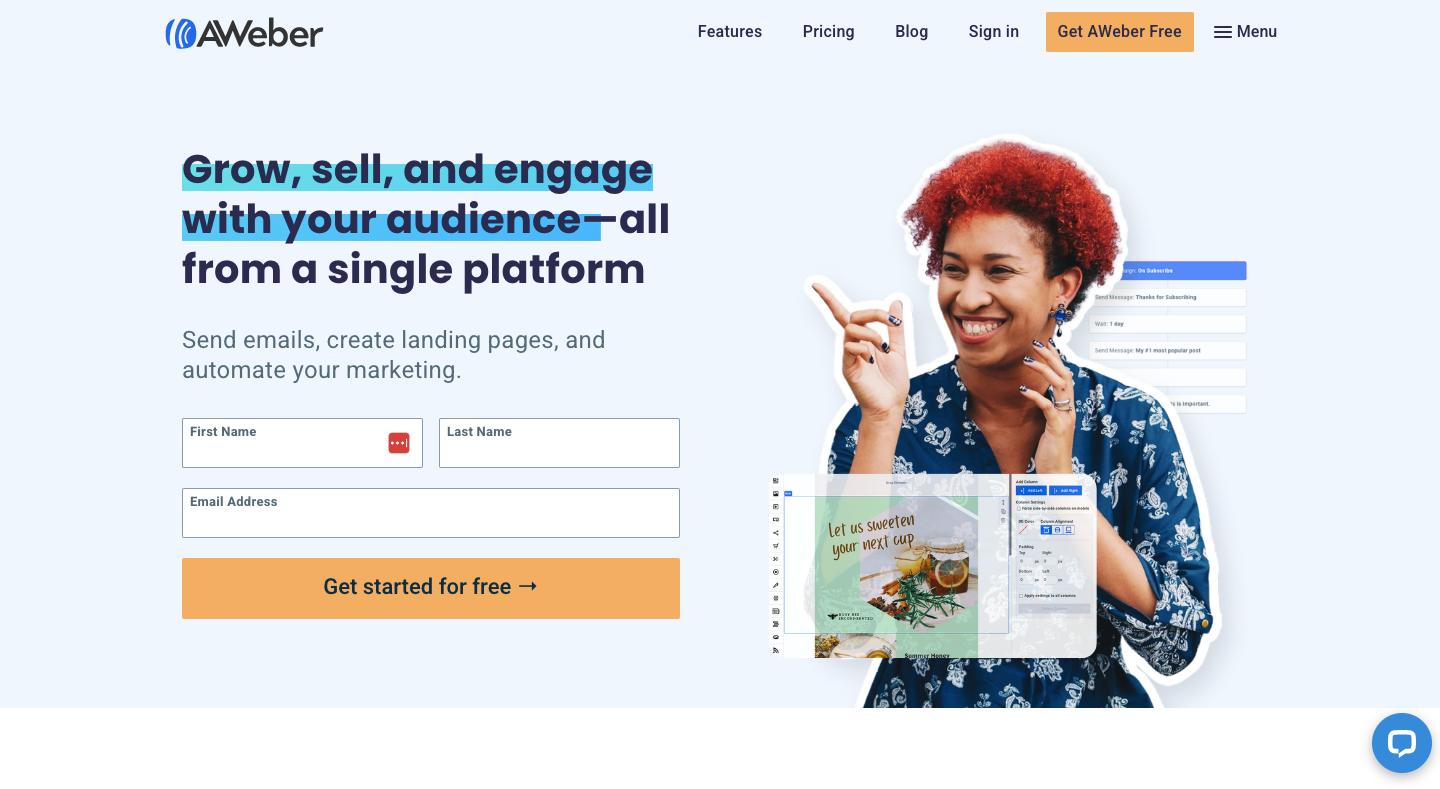 AWeber targets a similar audience to MailerLite—entrepreneurs and small businesses—and offers similar tools (email marketing, automation, landing pages, signup forms, and more). So is it a viable MailerLite alternative?
AWeber targets a similar audience to MailerLite—entrepreneurs and small businesses—and offers similar tools (email marketing, automation, landing pages, signup forms, and more). So is it a viable MailerLite alternative?
What Makes AWeber the Best MailerLite Alternative?
- More email templates. AWeber customers can access an astonishing array of email and newsletter templates, at 600+. They’re arguably less sophisticated than MailerLite’s templates—but if we’re only looking at the numbers, AWeber is the clear winner.
- More landing page templates. Similar story: there’s nothing wrong with MailerLite’s landing page templates, but AWeber offers a lot more of them. AWeber has almost 150 landing page templates at time of writing, compared to around 50 with MailerLite.
- Phone-based support. Simply put, MailerLite doesn’t do phone support; only live chat and email. With AWeber, you can pick up the phone and speak to a real human, regardless of which product tier you’re on. That’s right: even free users get over-the-phone support.
- Send push notifications. MailerLite has a ton of functionality, but it doesn’t include push notifications. Conversely, AWeber does offer push campaigns—even customers on its free tier can send them to up to 50,000 subscribers.
How Does AWeber Compare to MailerLite?
| AWeber | MailerLite | |
| Best Feature | Create email templates in seconds using your website or Facebook page URL. | Extremely generous free-for-life plan, including marketing automation and website, landing page, and form-building functionality. |
| Best For | Startups and small businesses | Email marketing beginners |
| Pros | More email and landing page templates. | Cheaper than AWeber, has a more generous free plan, and includes a built-in website builder. |
| Cons | Lacks advanced functionality, like sophisticated automations. | Smaller template library (although its templates are arguably higher-quality). |
| Pricing/Month | Free for up to 500 email subscribers and 3,000 monthly email sends; paid plans priced from $16.15 per month for up to 2,500 subscribers. | Free for up to 1,000 subscribers, including 12,000 monthly emails. Paid plans start at $9 per month for 1,000 subscribers and unlimited emails. |
| Support | All users—even free subscribers—can access 24/7 live support via phone, email, and chat (although paying customers are placed in a priority queue). | Free MailerLite accounts include 24/7 email and chat support for the first 30 days. All paying customers get 24/7 email support, while Advanced subscribers also get access to round-the-clock live chat support. |
6. ConvertKit
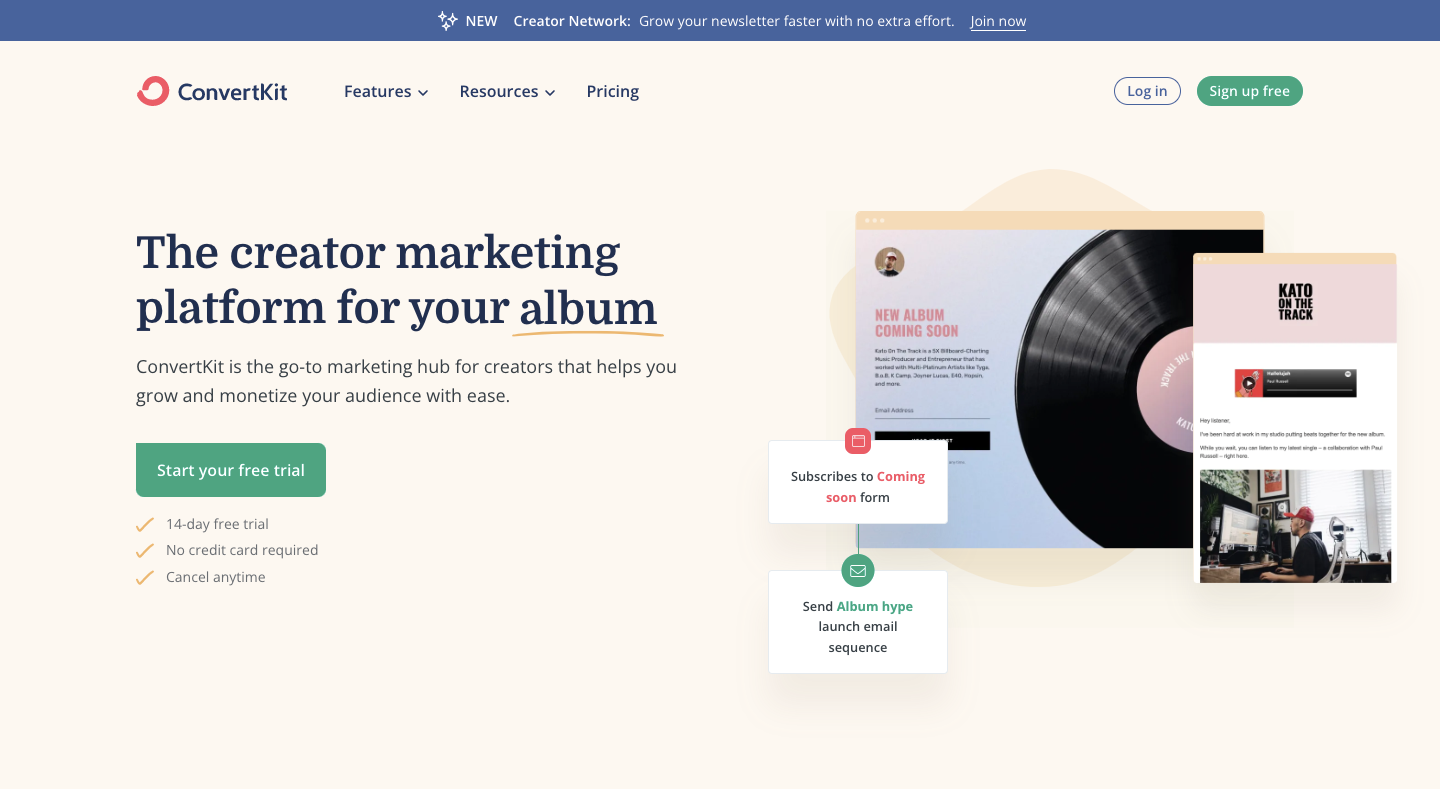 ConvertKit is one of a handful of feature-rich marketing tools designed for content creators, giving them access to form and landing page builders, automations, and—of course—email marketing. It’s amassed a base of 560,000+ customers, who have used the platform to reach over 600 million fans and followers worldwide.
ConvertKit is one of a handful of feature-rich marketing tools designed for content creators, giving them access to form and landing page builders, automations, and—of course—email marketing. It’s amassed a base of 560,000+ customers, who have used the platform to reach over 600 million fans and followers worldwide.
What Makes ConvertKit the Best MailerLite Alternative?
- Built for creators. MailerLite is a better fit for content creators than most marketing automation platforms. But it lacks some of ConvertKit’s dedicated, creator-friendly features. It also offers a lot of stuff creators might not need, making for a slightly more cluttered UI.
- Built-in referral marketing. Referral programs are one of the most reliable ways for creators to grow their audience—and ConvertKit has one built into its platform. MailerLite integrates with several referral marketing tools (including GrowSurf and SparkLoop), but you’ll have to pay extra for them.
- Unlock sponsorship revenue. ConvertKit helps creators with 10,000+ subscribers who send at least one newsletter a week find paid sponsorships, giving them another way to monetize their content. MailerLite isn’t built solely for content creators and doesn’t offer anything comparable.
- Better value for small-scale accounts. If you only have a tiny audience (<300 subscribers), ConvertKit’s free account might be a better fit than MailerLite’s, because it includes unlimited email sends.
How Does ConvertKit Compare to MailerLite?
| ConvertKit | MailerLite | |
| Best Feature | Integrated newsletter referral program helps creators grow their reach by leveraging their existing audience. | Extremely generous free-for-life plan, including marketing automation and website, landing page, and form-building functionality. |
| Best For | Content creators | Email marketing beginners |
| Pros | Easy-to-use engagement and monetization tools for content creators. | Intuitive, low-cost, feature-rich email marketing tools. |
| Cons | If you’re not a content creator, ConvertKit is a bad fit. | Lacks ConvertKit’s creator-friendly features, like referral marketing and support in finding sponsorships. |
| Pricing/Month | Free for up to 1,000 subscribers and unlimited email sends; paid plans start at $9 per month for up to 300 subscribers and unlimited sends. | Free for up to 1,000 subscribers, including 12,000 monthly emails. Paid plans start at $9 per month for 1,000 subscribers and unlimited emails. |
| Support | Paying customers get live chat and email support, with priority access offered to Creator Pro subscribers. Free subscribers only get community support. | Free MailerLite accounts include 24/7 email and chat support for the first 30 days. All paying customers get 24/7 email support, while Advanced subscribers also get access to round-the-clock live chat support. |
7. Brevo (FKA Sendinblue)
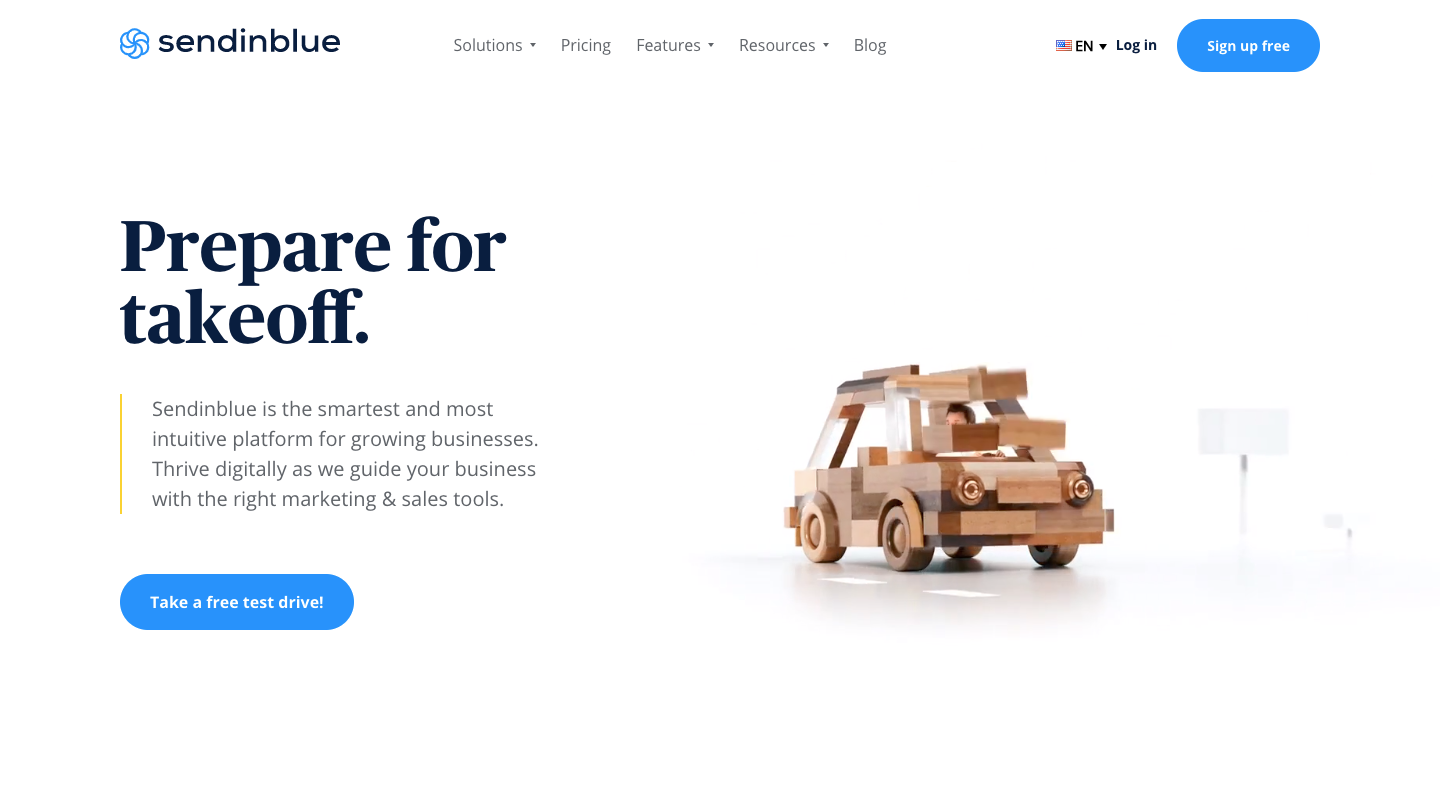 Brevo—or Sendinblue, as it used to be known—gives MailerLite some serious competition in the value-for-money stakes. Its free tier is superb and it does much more than “just” email marketing, incorporating SMS, WhatsApp, signup forms, and even the ability to manage Facebook ads.
Brevo—or Sendinblue, as it used to be known—gives MailerLite some serious competition in the value-for-money stakes. Its free tier is superb and it does much more than “just” email marketing, incorporating SMS, WhatsApp, signup forms, and even the ability to manage Facebook ads.
No wonder it’s used by 500,000 customers in 180 countries.
What Makes Brevo the Best MailerLite Alternative?
- Send more emails for free. On balance, we think MailerLite’s free plan is slightly more generous than Brevo’s because it offers more features. But if you’re just looking to send emails, Brevo is arguably a better fit. Its free plan allows you to send up to 300 a day to unlimited contacts—and it even includes free transactional emails.
- Reach unlimited subscribers. Both platforms offer superb value. However, Brevo charges by email sends and includes unlimited subscribers on all price plans (even the free one), while MailerLite charges by subscriber numbers and includes unlimited emails. So if you want more subscribers and fewer email sends, Brevo works out cheaper.
- Free CRM access. MailerLite doesn’t have a CRM platform; Brevo does—and it’s totally free.
- Built-in transactional emails. Brevo allows customers on all plans to send transactional emails—a vital tool for any ecommerce business. MailerLite technically doesn’t do transactional emails, although it does have a separate transactional email platform, MailerSend.
- Additional channels. While both MailerLite and Brevo are email platforms first and foremost, Brevo also allows brands to reach their audiences via SMS, WhatsApp, and even through Facebook ads.
How Does Brevo Compare to MailerLite?
| Brevo | MailerLite | |
| Best Feature | Send transactional emails with guaranteed 97 percent deliverability. | Extremely generous free-for-life plan, including marketing automation and website, landing page, and form-building functionality. |
| Best For | Low-budget email marketing | Email marketing beginners |
| Pros | Includes transactional emails and a CRM with all product tiers. | Offers unlimited monthly email sends on all paid account tiers. |
| Cons | More expensive for sending high email volumes; Starter customers need to pay an extra $12/month to remove Brevo branding. | No built-in SMS or WhatsApp campaigns; transactional emails require a separate tool. |
| Pricing/Month | Free for unlimited contacts and up to 300 emails per day. Paid plans start at $25 per month for unlimited contacts and 20,000 emails per month. | Free for up to 1,000 subscribers, including 12,000 monthly emails. Paid plans start at $9 per month for 1,000 subscribers and unlimited emails. |
| Support | The $25+ per month Starter plan only offers email-based support. To receive personalized support, you’ll need to subscribe to an Enterprise plan. | Free MailerLite accounts include 24/7 email and chat support for the first 30 days. All paying customers get 24/7 email support, while Advanced subscribers also get access to round-the-clock live chat support. |
8. Constant Contact
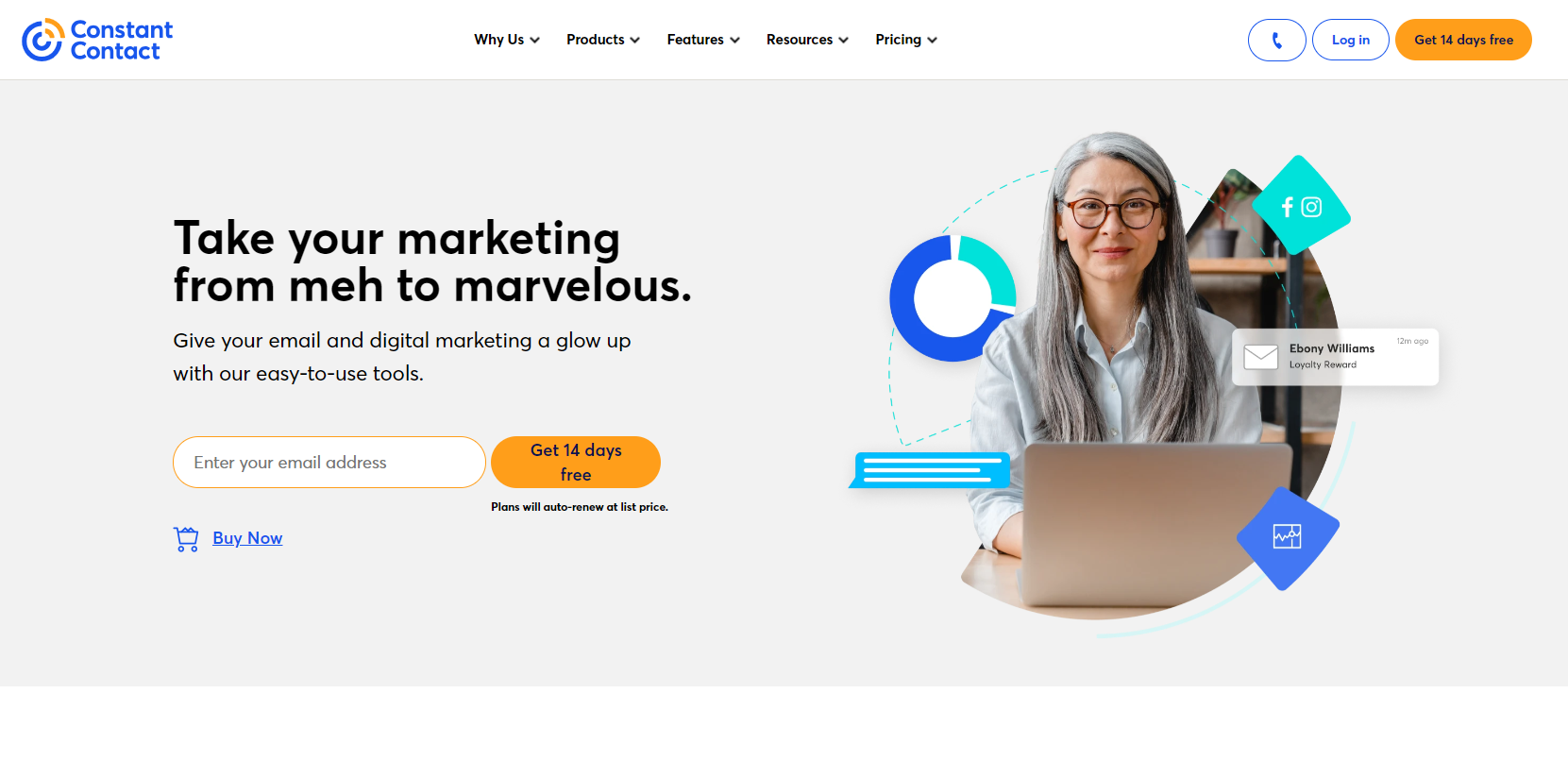 Constant Contact is a veteran of the email marketing world, starting out way back in 1995. Since then, the platform has evolved beyond email and now incorporates social media, SMS messaging, and marketing automation.
Constant Contact is a veteran of the email marketing world, starting out way back in 1995. Since then, the platform has evolved beyond email and now incorporates social media, SMS messaging, and marketing automation.
What Makes Constant Contact the Best MailerLite Alternative?
- Built-in social scheduling. Unusually for an email platform, Constant Contact allows you to create and schedule organic posts and paid ads for Facebook, Instagram, Twitter, and LinkedIn. You can’t do that with MailerLite.
- Phone-based support. MailerLite doesn’t offer any over-the-phone support, whereas all Constant Contact customers can pick up the phone to a support agent. Plus-level subscribers can also schedule personalized consultations.
- Inclusive event marketing tools. Another lesser-found feature: Constant Contact offers built-in event marketing support, allowing customers to build customizable registration forms, create email invitations, buy tickets, and track RSVPs in real time. You’ll need an integration to do most of that stuff through MailerLite.
- More email templates. Although it doesn’t give a specific number, Constant Contact promises “hundreds” of email marketing templates across multiple use cases. By contrast, MailerLite only offers about 50 email templates.
- Includes SMS marketing. You can’t run SMS campaigns through MailerLite without integrating a third-party tool, whereas US-based Constant Contact customers can add SMS marketing as a built-in bolt-on.
How Does Constant Contact Compare to MailerLite?
| Constant Contact | MailerLite | |
| Best Feature | Manage campaigns on the go from a dedicated mobile app. | Extremely generous free-for-life plan, including marketing automation and website, landing page, and form-building functionality. |
| Best For | Nonprofits and charities | Email marketing beginners |
| Pros | Lots of additional channels and tools, including SMS and event marketing. | Superb free product tier and cheap rates for high monthly email volumes. |
| Cons | No free tier and much higher prices. | No built-in support for SMS marketing. |
| Pricing/Month | From $9.99 per month for up to 500 contacts and 12,000 monthly email sends. | Free for up to 1,000 subscribers, including 12,000 monthly emails. Paid plans start at $9 per month for 1,000 subscribers and unlimited emails. |
| Support | Both paid plans offer live chat and phone support, while Constant Contact Plus subscribers also get personalized consultations to improve performance. | Free MailerLite accounts include 24/7 email and chat support for the first 30 days. All paying customers get 24/7 email support, while Advanced subscribers also get access to round-the-clock live chat support. |
9. GetResponse
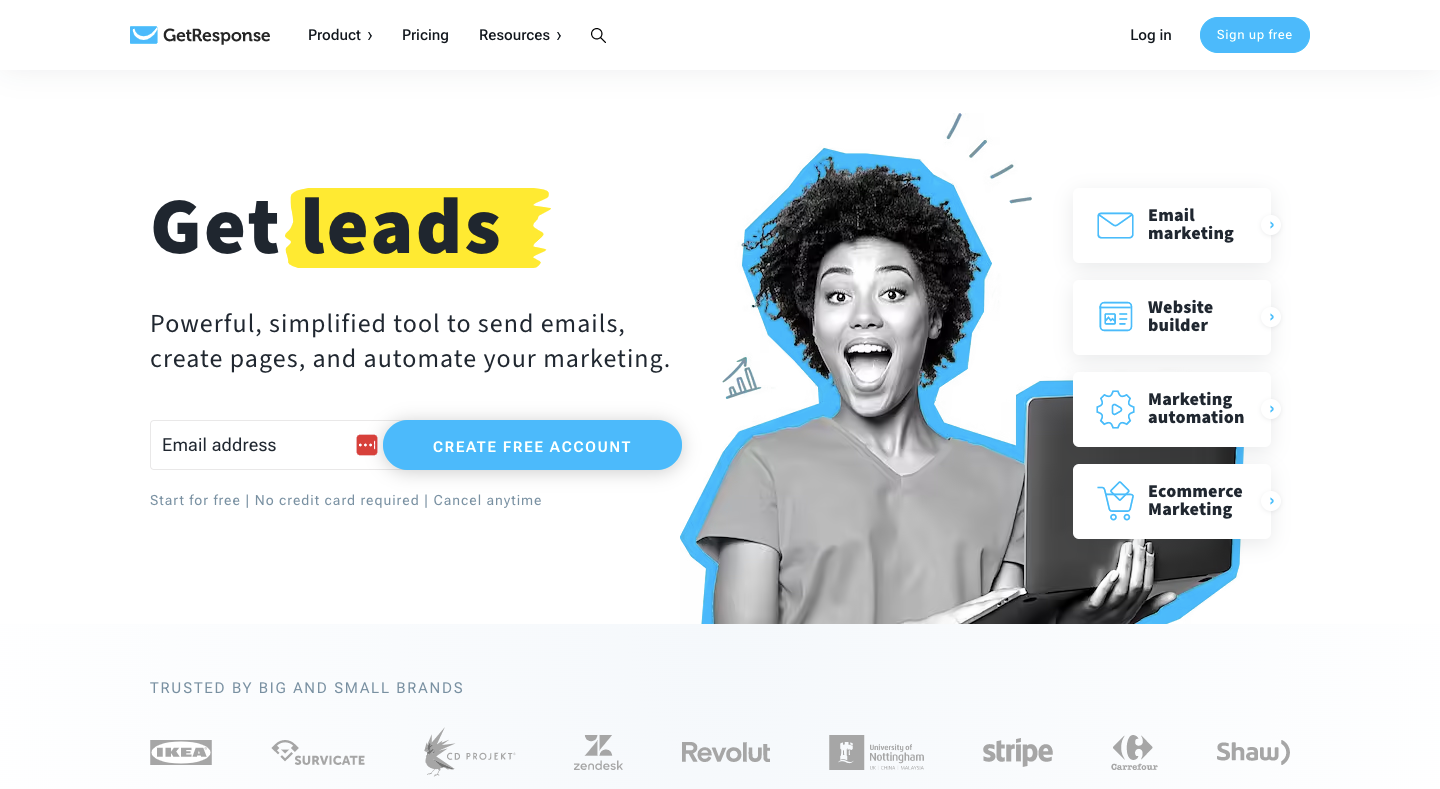 GetResponse is—guess what?—an email platform that also includes push notifications, SMS marketing, and marketing automation. More than 350,000 businesses have used GetResponse, including huge brands like Ikea and Zendesk.
GetResponse is—guess what?—an email platform that also includes push notifications, SMS marketing, and marketing automation. More than 350,000 businesses have used GetResponse, including huge brands like Ikea and Zendesk.
What Makes GetResponse the Best MailerLite Alternative?
- Best-in-class email deliverability. According to Email Deliverability Report, GetResponse offers higher deliverability than any other email tool, whereas MailerLite ranks toward the bottom.
- Built-in AI email generator. GetResponse has added its own GPT-3.5 powered email generator, available on all paid plans, helping you quickly craft engaging subject lines and email copy. At time of writing, MailerLite doesn’t offer anything similar.
- Integrated webinar hosting. Higher-tier GetResponse customers can leverage the platform’s built-in webinar hosting tools, whereas you’ll need an integration to run webinars through MailerLite.
- Additional marketing channels. With GetResponse, you can reach customers through SMS marketing, push notifications, and onsite live chat. MailerLite is email-only.
- Paid ads manager. GetResponse allows you to create and manage Google and Meta ads to build your audience and retarget non-converting website visitors. Again, you can’t do this with MailerLite.
How Does GetResponse Compare to MailerLite?
| GetResponse | MailerLite | |
| Best Feature | Built-in GPT-3.5 powered email generator. | Extremely generous free-for-life plan, including marketing automation and website, landing page, and form-building functionality. |
| Best For | Small businesses that need advanced marketing tools | Email marketing beginners |
| Pros | Superb email deliverability; tons of juicy extras (like webinar hosting and paid ad management). | Better free product tier and cheaper prices. |
| Cons | Significantly more expensive than MailerLite. | Only offers one marketing channel: email. |
| Pricing/Month | Free for up to 500 contacts and 2,500 monthly email sends. Paid plans start at $15.58 per month for 1,000 contacts and unlimited email sends. | Free for up to 1,000 subscribers, including 12,000 monthly emails. Paid plans start at $9 per month for 1,000 subscribers and unlimited emails. |
| Support | Paid plans include 24/7 support via chat and email. Phone support is only available at top-tier MAX2 level; some MAX2 customers can also access Slack support. | Free MailerLite accounts include 24/7 email and chat support for the first 30 days. All paying customers get 24/7 email support, while Advanced subscribers also get access to round-the-clock live chat support. |
10. HubSpot
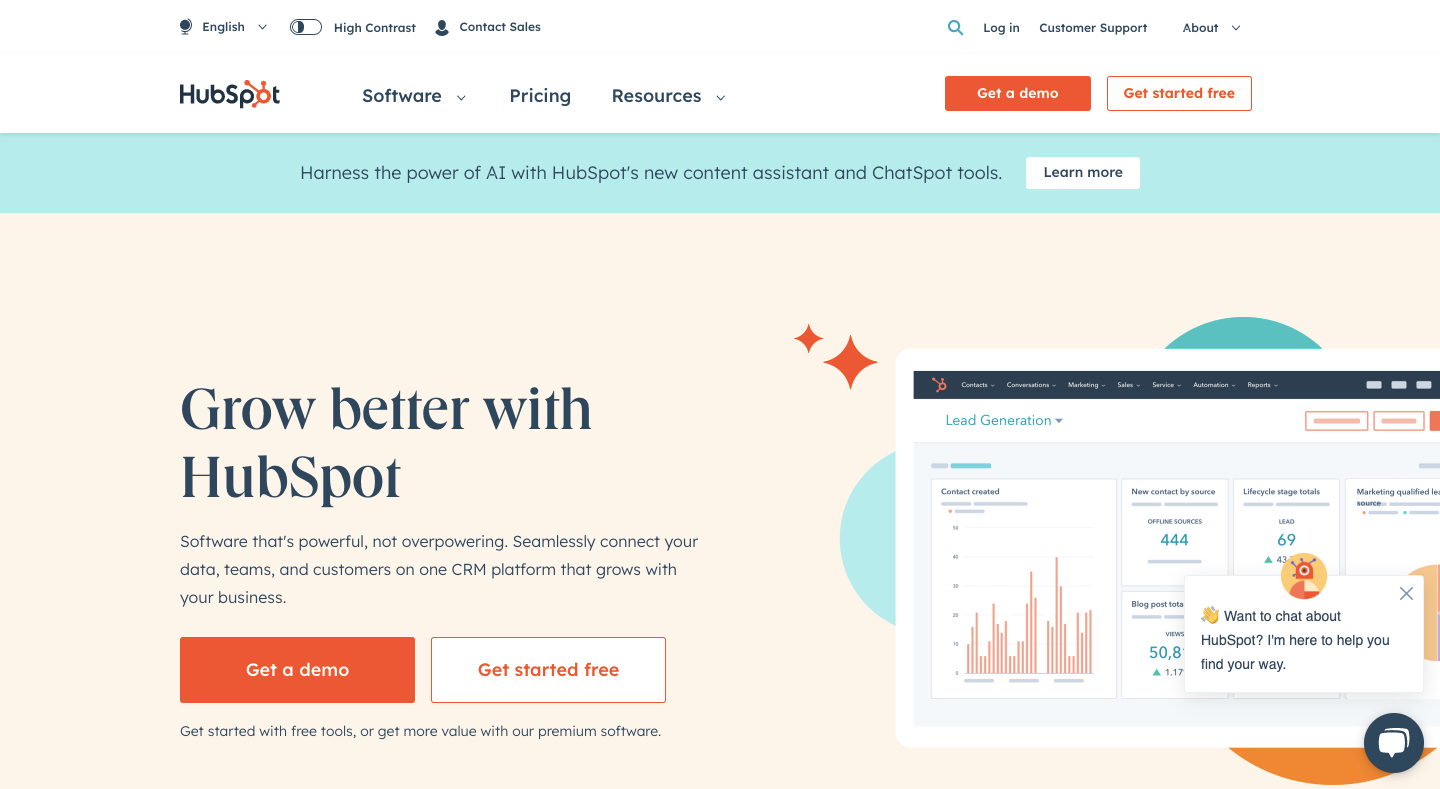 HubSpot is much more than an email platform, offering a giddying array of sales, marketing, operations, content management, and customer support functionality. That makes it hard to compare to MailerLite, which is predominantly an email marketing tool. So is HubSpot a potential MailerLite alternative?
HubSpot is much more than an email platform, offering a giddying array of sales, marketing, operations, content management, and customer support functionality. That makes it hard to compare to MailerLite, which is predominantly an email marketing tool. So is HubSpot a potential MailerLite alternative?
What Makes HubSpot the Best MailerLite Alternative?
- Free CRM. HubSpot offers a market-leading CRM, and you can access some of its tools free of charge, helping you keep track of individual customers and better understand their preferences. MailerLite doesn’t have any real CRM functionality.
- Unparalleled integrations. Most businesses can get all the integrations they need from MailerLite, but HubSpot offers way more, with 1,000+ integrations at time of writing.
- More landing page templates. Again, there’s nothing wrong with MailerLite’s landing page templates, but it doesn’t offer anywhere close to HubSpot’s bulging library of almost 350 templates.
- Built-in social posting. HubSpot Marketing Hub Professional customers can connect up to 50 social media accounts, publish 10,000 posts a month, and schedule posts three years in advance. You’ll need a third-party integration to do any of that through MailerLite.
- Over-the-phone support. HubSpot Pro subscribers can pick up the phone and speak to a HubSpot support agent, whereas MailerLite customers are limited to chat and/or email support, depending on their price plan.
How Does HubSpot Compare to MailerLite?
| HubSpot | MailerLite | |
| Best Feature | Connect marketing, sales, content management, and customer service in a single platform. | Extremely generous free-for-life plan, including marketing automation and website, landing page, and form-building functionality. |
| Best For | B2B inbound marketing | Email marketing beginners |
| Pros | An all-in-one sales and marketing platform with an excellent (free) CRM. | Much cheaper price plans, including an excellent free tier. |
| Cons | Expensive subscriptions and high onboarding fees. | Only offers a fraction of HubSpot’s functionality. |
| Pricing/Month | Free marketing plan includes unlimited contacts and 2,000 monthly email sends. Paid marketing plans start at $18 per month for 1,000 contacts and 5,000 monthly sends. | Free for up to 1,000 subscribers, including 12,000 monthly emails. Paid plans start at $9 per month for 1,000 subscribers and unlimited emails. |
| Support | Paying customers can get 1:1 email and in-app chat support. Phone support is available at Pro level and above. | Free MailerLite accounts include 24/7 email and chat support for the first 30 days. All paying customers get 24/7 email support, while Advanced subscribers also get access to round-the-clock live chat support. |
Frequently Asked Questions
MailerLite is hard to beat as a low-cost, easy-to-use email marketing platform. Its free-for-life product tier is arguably the best on the market, and its paid plans offer superb value for money. But there are lots of potential MailerLite alternatives offering more features or more dedicated support for specific industries.
No, Google doesn’t have a direct MailerLite alternative, although you can run basic email marketing campaigns through Gmail using a third-party app.
MailerLite is certainly one of the best-value email platforms. But whether it’s the best choice for your business depends on your specific requirements. If you’re looking for more than just email marketing (e.g. SMS or push campaigns), it’s not the one for you. And most ecommerce brands will be better served by a dedicated ecommerce automation platform like Drip or Klaviyo.
MailerLite does exactly what it sets out to do: offering a high-quality, low-cost, intuitive email marketing platform. But while it offers a few tasty extras, like a website and landing page builder, it has pretty basic reporting and lacks support for additional marketing channels like SMS.
Conclusion
If you want to send a ton of emails for the lowest possible cost, MailerLite is an absolute no-brainer. And it offers a few features that put some of its more expensive peers to shame—not least its excellent drag-and-drop editor, solid form builder, and built-in website builder.
But its ecommerce functionality is pretty limited. For anyone other than the smallest ecommerce brands, we’d strongly recommend an industry-specific, revenue-focused platform like Drip.
Take us for a test drive by signing up for your 14-day free trial today.
